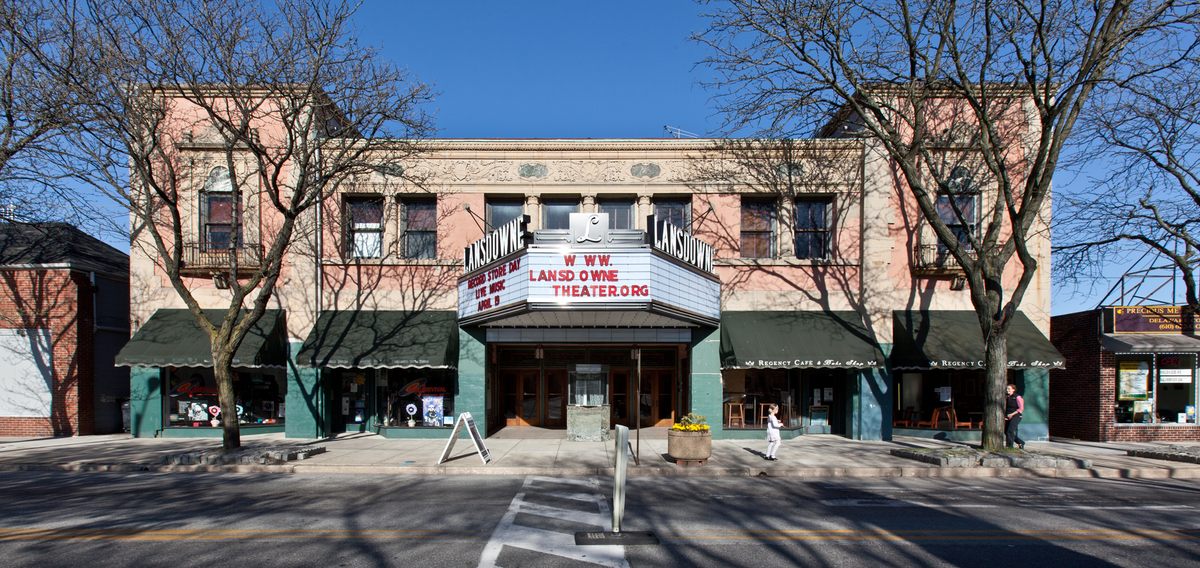
A Case for the Preservation of Abandoned Places
Finding where history, passion, and urban development come together can mean a lot to a community.

When I first moved to Lansdowne, Pennsylvania, a decade ago, I was immediately intrigued by the grand façade of the old theater in the center of town. Lansdowne, a small borough two miles southwest of Philadelphia, has the usual collection of dry cleaners and fast-food franchises, but the 1927 Spanish Revival theater stood out, both in its sense of quiet grandeur and the dark absence that radiated from its lobby. As a chronicler of abandoned places, I had to learn more. After a few calls and emails, I arranged to meet with Matt Schultz, CEO of the nonprofit Historic Lansdowne Theater Corporation. It’s always an amazing feeling when you finally get the opportunity to visit and photograph a place you’ve been curious about for months. The Lansdowne Theater didn’t disappoint: the red, gold, and blue auditorium boasted a spectacular 270-light-bulb chandelier, a tattered but regal curtain over the stage, and antique projectors still in the projectionist’s booth. As Schultz told me about the nonprofit’s goal to turn the theater into a music venue, I couldn’t help but notice what a massive job he had ahead of him.
While the light fixtures and frescoes were gorgeous, three decades of vacancy had left water-damaged plasterwork and holes in the ceiling that would take millions to repair. Schultz was much more pragmatic and business-savvy than most people I’ve met who buy abandoned properties with the hopes of restoring them—and I’ve met quite a few, often with little more than passion and a dream. Over 16 long years, Schultz had put together a solid board for the corporation, solicited the support of state lawmakers, courted volunteers and donors, and commissioned architectural studies.

Even after I moved away from the area, I revisited Schultz and the theater again and again over the years, and the building looked the same: beautiful, but cold and empty. A previous owner also had grand ambitions for it but ultimately went bankrupt and closed the theater in 1987 after a small electrical fire during a screening of Beverly Hills Cop II. Though I wanted to believe saving the building was possible, I secretly wondered if Schultz’s plans would ever become reality, or if The Lansdowne would wind up being yet another magnificent, abandoned place that would ultimately be demolished.
I clearly love abandoned places as they are, but my ultimate hope is to see them transformed into something that can benefit communities again. I’d prefer the photographs I take of vacant buildings show progress rather than document loss. This is not just sentimentality or nostalgia—retaining the inherent character of neighborhoods with historic architecture has clear and measurable benefits. A well-managed and maintained historic district can serve as the linchpin for an entire area. Though it is only one part of New York’s recent prosperity, according to Forbes, Manhattan’s Broadway Theater District “contributes $14.7 billion to the economy of New York City on top of ticket sales and supports 96,900 local jobs.” In the 1970s, however, the Theater District was run-down and seedy, and many of the grand theaters built during its golden age were dilapidated and in need of repair. By the time skyscrapers were sprouting up in the area in the early 1980s, many landmark theaters were threatened. Five were destroyed in 1982 alone. Had preservationists not pitched a fierce legal battle to save them, it’s likely many more would have been lost. Ultimately, the decision to invest in the theaters rather than destroy them allowed them to continue as a vital part of the neighborhood’s tourist economy today.

Smaller towns have different challenges, and unfortunately not every historic site can support all of an area’s financial needs. That said, historic districts do tend to draw visitors, and those visitors patronize shops, restaurants, and hotels. It’s easy to write off the loss of a single building, but the unraveling of a community happens a thread at a time, and when a distinctive building or area is replaced with franchises and chain stores, more than character is lost—potential disappears. Nearly every time I’m in Pittsburgh, I visit the Church Brew Works, a restaurant and brewery housed in the formerly vacant St. John the Baptist Church. I don’t go there for the food (which is quite good); I go there for the experience. My favorite part of Toronto is the 13-acre Distillery District, a collection of shops, galleries, small businesses, and eateries nestled in a complex of stunning Victorian buildings that were once the abandoned Gooderham & Worts whiskey distillery. Eastern State Penitentiary in Philadelphia was similarly at risk of being torn down to make way for luxury apartments, a theme park, or a shopping center until a group of architects, historians, and preservationists used public tours to explore the history of the carceral state; currently Eastern State draws 220,000 annual visitors. One has to wonder if any of the businesses in the tiny hamlets around Bodie, California, would exist if the ruins of the abandoned gold-mining town hadn’t been turned into a State Historic Park that attracts 200,000 tourists a year.
Nearly every successful historic attraction has had a period of peril like the one the Lansdowne Theater has experienced: the magnificent Paramount Theatre in Austin, Texas, the immigration portal at Ellis Island, or the lazaretto on the island of Spinalonga in Greece all could have been lost. Even the Alamo was once abandoned. Instead, they now generate income and employment, while offering a rare and precious glimpse into the past. At the time when they were abandoned, however, efforts to save them probably seemed to some quixotic and doomed to fail. When faced with a building some might view as an eyesore, having the vision to rehabilitate vacant landmarks has been the salvation for countless towns.

In debates over whether a building should be saved, sentimentality has a role but rarely wins on its own. I’m as guilty of it as anyone. There’s a deep sadness to watching a beautiful piece of architecture fall into ruin, and an even greater sorrow in seeing it lost forever. The actual decision-making process rarely takes feelings into consideration, however. Developers and city planners want to see tangible financial benefits; going to a meeting about whether an abandoned building should be saved with a heartfelt plea about historical significance alone is like bringing a knife to a gunfight. These battles are much more likely to be won or lost by dedicated people who can translate their passion into the language of feasibility statistics and long-term projections—the language spoken by local politicians, investors, and lawmakers.
Despite setbacks and heartaches, major construction on the Lansdowne Theater finally began in 2023, and it is expected to reopen as a concert venue in fall 2024. Matt Schultz projects that the restored theater will attract 100,000 visitors yearly, spurring millions of dollars in business growth, tax revenue, jobs, and investment. Throughout the process he stressed the practical, attainable impact the theater will have on the neighborhood around it. Schultz, a local historian who has dedicated much of his career to preservation work, understands the value of memories, too.

“I think we all yearn for something permanent in a world that seems to be changing at an increasingly fast pace. The preservation of objects, landscapes, or structures help us to remember experiences, good or bad,” he wrote to me. “I choose to take on preservation projects in my long-time hometown, Lansdowne, PA, because it is a treasure trove of American architecture from the 18th century through the 1960s. A tapestry is woven through the buildings, stories of the past and present residents make this community special. Through projects such as the restoration of the Lansdowne Theater, I have heard from hundreds of people who have fond, funny, or heartbreaking stories that happened in the community.” Schultz also understands, though, that investors want to see another success story like The Met, formerly the long-abandoned Metropolitan Opera House and now a mixed-use destination concert venue that is breathing life back into its once-blighted pocket of North Philadelphia.
Watching the Historic Lansdowne Theater Corporation complete roof repairs, install a new gutter system and retaining wall, and perform selective interior demolition in preparation for construction gives me hope. Historic structures anchor our communities, give us places to look forward to visiting, and encourage investment in the towns we live in. They serve as beacons that foster the growth of independent businesses, contribute to the joy and magic of travel, and inspire us to create new memories. After all, nobody travels to a different state to visit a Walmart.

You can follow the progress of restoration at the Lansdowne Theater, see images of the theater in its abandoned state, or listen to my interview with Matt Schultz about restoring the theater.
Matthew Christopher is a writer and photographer who has explored abandoned locations across the globe for two decades, chronicling the lost landmarks in our midst. You can find more of his work on his website Abandoned America or listen to his Abandoned America podcast.




























Follow us on Twitter to get the latest on the world's hidden wonders.
Like us on Facebook to get the latest on the world's hidden wonders.
Follow us on Twitter Like us on Facebook